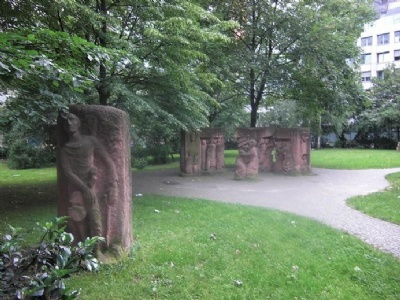Berlin – Rosenstrasse
In the autumn of 1941, the Nazis began deporting German (including Austria and Bohemia-Moravia) Jews to ghettos in eastern Europe and later even directly to extermination camps. The Jews who were not subject to these deportations until 1943 were mainly those who worked in the war industry (Fabriksjuden), jews who fought for Germany during the First World War or jews who were married to german aryan women. But in early 1943, the Nazis planned to begin the deportation of these to the extermination camps. Such an action was carried out in Berlin at the end of February. The Nazis began without warning to the pick up Jews at their workplaces, homes or simply on the streets and brought them to various assembly halls around Berlin. One was on Grosse Hamburger Strasse, another was on Rosenstrasse 2 – 4 near Alexanderplatz, where about 1700 Jewish men who were married to German women were locked up. Rumors of arrests spread rapidly. Immediately a few wives and other relatives began to gather outside the building on Rosenstrasse to demand the release of the husbands. These were women who did not listen to the regime’s call to divorce their Jewish spouses. When the regime called on Germans who were married to jews or mischlinge (not hundred percent jews) to divorce their jewish spouses, there were far more men who filed for divorce than vice versa.
After a few days, hundreds of people had gathered and protested against the arrests and demanded the release of the men. They stood outside the house day and night and chanted ”we want our men back” and made a further deportation of the Jews impossible. In the end, those responsible for the arrests felt that Berlin gauleiter Josef Goebbels had to be contacted on how to deal with the situation. It would be easy to believe that the Nazis also arrested those who protested and sent them off to some concentration camp or murdered them, but this was not the case. This was just after the defeat at Stalingrad and the regime was in need of all the support it could get. Of course, there were threats that those who protested would be shot, but as soon as the crowd was dispersed by threats, they returned and continued the protests. Those who protested at Rosenstrasse had previously been indifferent when other Jews were deported and it was this indifference that the Nazis sought. But when it was their own relatives who were to be deported, it was different. The RSHA (Reich Central Security Service) did not take into account the protests, but for their part it was about making the capital of the kingdom free of Jews at any cost. But Goebbels, who were the Gauleiter of Berlin, and thus higher in rank, saw it all differently.
Goebbels, after the defeat at Stalingrad, had to take into account popular opinion in Germany. He had also in his speech at Berlin’s Sports Palace a few weeks earlier urged the women (in Germany) to step into the war industry. He was thus even more dependent on the consent of women to the regime’s call for a total war. Goebbels decided to release the Jewish men who were married to German women on March 6, 1943. In this way, the moral order was restored and those who protested returned to life before the arrests and left the regime in peace. It was hardly out of mercy that the men were released, but it was a situational adaptation to the political situation on the part of Goebbels. It was simply that it was not the right time for the regime to solve the problem of these approximately 1700 Jews. It had to wait until later when the conditions for the regime were more favorable to get rid of these jews. Goebbels knew that order would be restored because the protests were aimed at nothing more than the release of their men. None of those protesting were later arrested despite the fact that at the end of the protests they also chanted ”killers”. Had it been anywhere in Eastern Europe, the fate of the Jews had long been solved without regard whether they were married to non-Jews. But in Germany it was different because it was about people (german) whom the regime claimed to represent.
Current status: Demolished with monument (2010).
Address: Rosenstrasse, 10178 Berlin.
Get there: Metro to Hackescher markt Station.
Follow up in books: Stoltzfus, Nathan: Rosenstrasse (2004).

To protest openly against the Nazi regime could put one’s life at stake, but the events on Rosenstrasse also show that protests could cause the regime to compromise with its own ideology. It shows that the regime’s power was based on popular support rather than on terror. Terror was used to create a balance between the regime and the people.